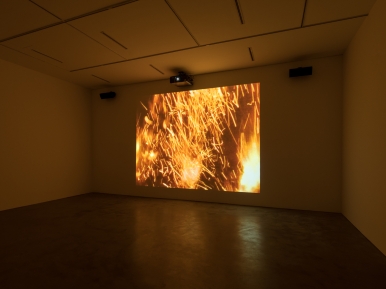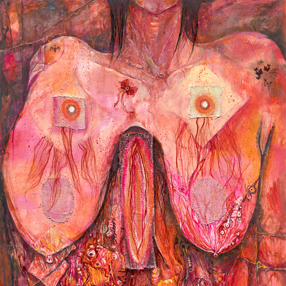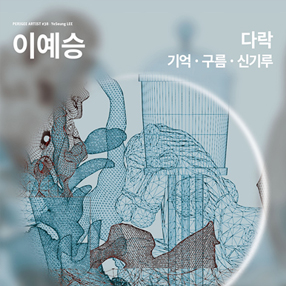본문
-
빌 비올라
국제갤러리 K1 1층 빌 비올라 개인전 《Moving Stillness》 설치전경, 이미지 제공: 국제갤러리
빌 비올라
국제갤러리 K1 1층 빌 비올라 개인전 《Moving Stillness》 설치전경, 이미지 제공: 국제갤러리
빌 비올라
국제갤러리 K1 1층 빌 비올라 개인전 《Moving Stillness》 설치전경, 이미지 제공: 국제갤러리
빌 비올라
국제갤러리 K1 1층 빌 비올라 개인전 《Moving Stillness》 설치전경, 이미지 제공: 국제갤러리
빌 비올라
국제갤러리 K1 1층 빌 비올라 개인전 《Moving Stillness》 설치전경, 이미지 제공: 국제갤러리
빌 비올라
국제갤러리 K1 1층 빌 비올라 개인전 《Moving Stillness》 설치전경, 이미지 제공: 국제갤러리
빌 비올라
국제갤러리 K1 2층 빌 비올라 개인전 《Moving Stillness》 설치전경, 이미지 제공: 국제갤러리
빌 비올라
국제갤러리 K3 빌 비올라 개인전 《Moving Stillness》 설치전경, 이미지 제공: 국제갤러리
Press Release
국제갤러리는 오는 12월 3일부터 내년 1월 26일까지 서울점 K1(1, 2층)과 K3에서 빌 비올라(Bill Viola)의 개인전 《Moving Stillness》를 개최한다. 국제갤러리에서의 네 번째 개인전이자 지난 7월 작가가 작고한 후 한국에서 처음으로 진행되는 이번 전시는 빌 비올라의 삶과 작업세계를 핵심적으로 아우르는 영상 설치 및 영상 작품 7점을 선보인다. 1951년 뉴욕에서 태어난 빌 비올라는 지난 50여 년간 비디오아트를 현대미술의 주요 장르로 확립하는 데 선구자적인 역할을 했다. 강렬한 영상 설치 작업으로 널리 알려진 비올라는 영상 기술을 통해 인식, 인지, 자아 성찰의 다양한 방식을 실험해왔다. 자신의 영상을 “주관적 인식의 언어로 기술한 시각적 시(詩) 내지는 우화”라고 표현하기도 한 그는 출생, 죽음, 의식의 흐름, 자연의 순환 등과 같은 인간의 보편적인 경험을 상기시키는 은유로서 영상 매체의 광학적, 기술적 속성을 작업에 접목시켰다. 비올라의 작업은 불교의 선종, 이슬람의 수피교, 기독교의 신비주의와 같은 영적 전통에 기반을 둔 영상 언어를 특징으로 삼아 특유의 심도 깊은 휴머니즘과 내면의 초월적인 비전을 감각적으로 구현한다.
이번 전시는 K3에 설치된 영상 작품 〈 Moving Stillness: Mount Rainier 1979 〉(1979)을 중심으로 전개된다. 공중에 ‘떠 있는’ 스크린에 투사되는 산의 이미지가 스크린 바로 아래의 물 웅덩이에 반사되는 구조인데, 이때 물 표면의 일렁임에 따라 산의 모습도 함께 흔들린다. 즉, 물의 표면에 생기는 약간의 파동 및 움직임에도 강직하고 불변하는 이미지로 존재하던 산의 개념이 흐트러지게 된다. 한번 흔들린 물과 산은 어느 정도의 시간이 흘러야 비로소 잠잠해지며 안정을 되찾는다. 작가는 이렇듯 보통은 정적이고 단단한, 시간의 기념비로서 존재하는 산을 취약하고 불안정한 이미지로 제시함으로써 이미지로서의 산이 갖는 성격을 고찰하도록 한다. 이에 관람객들은 작가가 제안한 ‘흔들리는 산’의 모습을 통해서 안정감의 함정에 대해, 또 한편으로는 시간의 축적이 건네는 안식에 대해 되짚어볼 수 있다.
K1에서는 빌 비올라의 초기 비디오테이프 작품들을 세 대의 CRT 모니터를 통해 만날 수 있다. 로비에 설치된 〈 Information 〉(1973)은 제작과정의 기술적 오류를 영상 매체의 물리적 속성 탐구의 계기로 삼은 작품인 한편 바깥쪽 전시장에 놓인 〈 Four Songs 〉(1976)는 영상과 사운드의 조합이 빚는 은유적 화면을 통해 개인이 자연과 교류하는 과정에서 마주하게 되는 여러 심리적, 감정적 역학을 서술한다. 또한 〈 Ancient of Days 〉(1979–81)에 대해서 작가는 “시간의 흐름에 내재된 속성을 표현하는 영상을 위한 일련의 푸가(fugue)”라고 작가노트에 표현한 바 있다. 이와 함께 전시장에는 2006년도 작품 〈 Poem B (The Guest House) 〉도 보여지는데, 벽면에 설치되는 세 대의 평면 모니터로 구성된 일종의 ‘비디오 삼면화(triptych)’를 통해 우리는 한 여성이 자신의 삶을 앞뒤로 반추하며 겪는 “추억의 날 선 고통과 묻힌 이야기들의 둔한 통증”을 엿볼 수 있다.
K1의 안쪽 전시장은 작가가 제46회 베니스비엔날레 미국관 전시를 위해 제작한 1995년도 작품 〈 Interval 〉에 헌정된다. 방 안에는 두 개의 대형 프로젝션이 서로를 마주보는 모양새로 설치되는데, 한쪽에서는 나체의 남성이 샤워실 안에서 천천히 자신의 몸을 헝겊 천으로 조심스럽게 닦아 내리는 와중에, 반대편 화면에는 불과 물의 이미지와 신체 구멍을 노골적으로 클로즈업한 이미지들이 투사된다. 이렇듯 한 공간 안에 서로 상충하는 두 종류의 에너지, 즉 평화로운 것과 폭력적인 것, 수동적인 것과 능동적인 것이 양쪽에 병치되는데, 두 영상의 재생 속도가 점차 빨라지다 결국 폭발적인 절정에 이른 후 두 개의 화면이 돌연 블랙아웃 되면서 하나의 시공간으로 통합된다.
마지막으로 K1의 2층 전시장에서는 〈 The Reflecting Pool 〉(1977–9/1997)을 소개한다. 숲 속의 연못을 드나드는 움직임을 담은 본 작품을 통해 작가는 물을 정신적 재탄생의 매개체로 은유 및 규정한다. 어린 시절 호수에 빠져 거의 익사할 뻔한 찰나의 순간에 작가가 수면 아래에서 목격한 빛과 아름다움은 이후 그의 작업세계에서 초월적인 차원으로 자리매김했다. 또한, K3에 설치된 〈 Moving Stillness: Mount Rainier 1979 〉과 마찬가지로 이 작품에서 역시 관람객은 수면의 반사체, 그리고 일렁이는 물결들을 통해 의식의 여러 층위를 아우르며 시공간에 대한 대안적 인지 방식을 재고하게 된다.
빌 비올라는 〈 Moving Stillness: Mount Rainier 1979 〉 작품이 전달하고자 하는 의미에 대해 “산이라는 이미지는 일견 견고하고 변함없는 상수(constant)의 성격을 띠는 것 같지만, 사실 그 상수로서의 성격은 일련의 요소들이 그 순간 우연적으로 맞아떨어진 결과일 뿐이며, 각 변수는 제각기 독립적이고 끝없이 가변적”이라 설명한 바 있다. 우리의 삶이 무한한 변수로 구축된 환경 안에서 각자의 균형을 찾아 나가는 과정의 여정이라면, 이번 전시는 각자의 인생 속 고유한 상수에 대해 고찰해 볼 기회를 제공하고자 한다. 거대한 시간의 흐름 속에서 그 상수와의 만남이 비록 찰나일지라도, 일련의 힘들이 합을 맞춰 만들어낸 우연의 기적적 순간이 건네는 위로를 포착하고 만끽하는 장이 되기를 기대한다.
Kukje Gallery is pleased to present Moving Stillness, a solo exhibition of work by Bill Viola from December 3 to January 26. The first exhibition devoted to Viola in Korea since his passing this past summer, it brings together a wide range of works to celebrate his incredible life and art practice. Born in New York in 1951, Bill Viola was a seminal figure in the founding and development of video art. Widely recognized for his powerful installations, Viola used video technology to explore modes of perception, cognition, and the pursuit of self-knowledge. Describing his videos as “visual poems, allegories in the language of subjective perception,” Viola experimented with the optical and technical properties of video as metaphors for evoking universal human experiences—namely, cycles of nature, birth, death, and the flow of consciousness. Characterized by moving imagery grounded in spiritual traditions, including Zen Buddhism, Islamic Sufism, and Christian mysticism, his unique aesthetic embodies a poignant sense of inner vision highlighting his profound humanism.
Anchoring the exhibition is Moving Stillness: Mount Rainier 1979 (1979), installed in K3. This powerful installation depicts the mountain being reflected in a pool of water via a rear projection screen which causes the image of Mount Rainier to be dependent on the state of the water’s surface. Any small disruption directly impacts the image and therefore, challenges the notion of a solid and immobile mountain. The faltering image of the mountain is stabilized only after time allows for the water to become still. In experiencing the distorted image of the mountain created by Viola, viewers confront a poetic illustration of time and the illusion of stability, while also experiencing a work of tremendous beauty and calm.
K1 introduces a collection of Viola’s earliest videotape works on CRT monitors. Information (1973) embraces a technical mistake of production into an investigation of the material traits of the electronic medium; Four Songs (1976) portrays a collection of visual allegories in which the composition of video images and sounds narrates the psychological and emotional dynamics of the individual in interaction with the environment; and Ancient of Days (1979-81), as the artist himself has described, is “a series of canons and fugues for video expressing the nature of the passage of time.” Also, in the front room of K1 is Poem B (The Guest House) (2006), a triptych of three flat panel monitors mounted on the wall, through which we share “sharp pains of memory and dull ache of hidden stories” of a woman reflecting on the past and future of her life.
The rear room of K1 is dedicated to Interval (1995). A significant work by the artist produced for his participation in the 46th Venice Biennale, the work is composed of two large projections that stand opposite each other. On one side of the room is an image of a naked man in a shower room slowly washing himself with a cloth. On the opposite side of the room is projected a series of violent images of fire and water intercut with close-ups of body orifices. The images are never present on opposite walls simultaneously. The juxtaposition of the two opposing energies of the peaceful and the violent, or the passive and the aggressive, is gradually bridged as the computer-controlled sequence of images is progressively sped up to a climax of volatile speed before an abrupt blackout on both screens.
Finally, on the second floor of K1 is The Reflecting Pool (1977-9/1997). In this installation, we see the artist himself interacting with a pool of water framing the visual metaphor of water as a medium of spiritual (re)birth. The reflections and disturbances caused on the surface of the water in this work once again provides an alternative perception of time and space, highlighting different layers of the mind and consciousness.
Of Moving Stillness, Viola has said, “the apparent solid, constant character of the image of the mountain is only due to a moment-to-moment coincidence of a set of factors, each independent and minutely variable.” In this journey of finding our balance among the infinite variables of our surroundings, it is through this exhibition that we invite our audience to come and contemplate their own constants in life. However fleeting or faltering the encounter with that unique constant may be in the larger trajectory of time, stars certainly aligned to produce that moment of coincidence.전시제목빌 비올라: Moving Stillness
전시기간2024.12.03(화) - 2025.01.26(일)
참여작가 빌 비올라
관람시간10:00am - 06:00pm / 일, 휴일 10:00am - 05:00pm
휴관일매주 월요일
장르비디오
관람료무료
장소국제갤러리 Kukje Gallery (서울 종로구 소격동 58-1 K1, K3)
연락처02-733-8449
Artists in This Show
1951년 미국 뉴욕출생
국제갤러리(Kukje Gallery) Shows on Mu:um
Current Shows



























